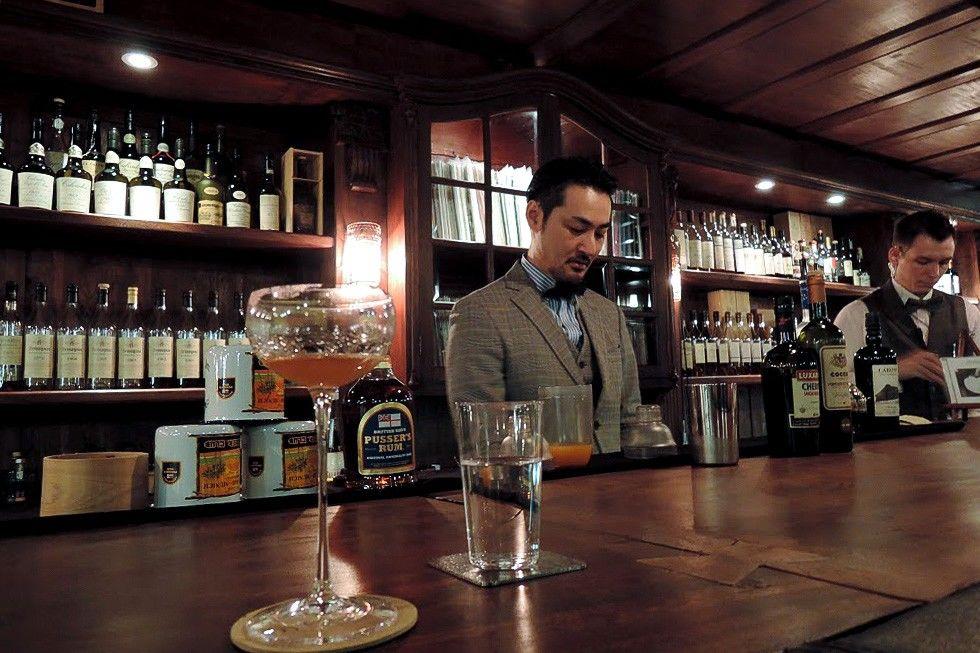Craftsmanship inherited overseas: Immigrated sushi chefs, bartenders, cosmetologists
The Japanese population in Japan is declining due to the declining birthrate, but the number of Japanese living overseas is increasing year by year and has exceeded 1.35 million. About 1% of the Japanese live abroad and are building a living base abroad. Focus on migrants working in restaurants and beauty salons in Asian countries and think about their commitments that can be seen in their daily work.
Hong Kong sushi chef: Taking advantage of 15 years of training experience
Yoshihide Takahashi (40 years old, pseudonym) begins to grasp the next story as soon as he puts a grip on the counter saying "Yes, Nakatoro". Even though it was before 7 pm, the counters and tables were full. Mr. Takahashi uses lean movements to grab the rice one after another, grasping the material, mixing cantonese and English in one word, and making jokes with exaggerated gestures to make customers laugh. Mr. Takahashi, a sushi chef, has lived in Hong Kong for the seventh year. After graduating from high school, he trained in Nihonbashi, Tokyo for 15 years and is now in charge of a luxury sushi restaurant in central Hong Kong.
Mr. Takahashi tells the local staff, "Tea for the waiting customers!" Employees give tea and menus to customers sitting in chairs lined up outside the store. The waiting guest sips tea, looks at the pictures on the menu, and enjoys talking with the next guest. In Hong Kong, there is almost no service to waiting customers, and it is popular as a "service from Japan".
Mr. Takahashi's training days were harsh. When he started his apprenticeship, he only washed dishes, cleaned cutting boards and knives, and cleaned the floor, and had few chances to touch the rice and sushi. Even if he wanted to learn how to hold sushi, he wasn't in the mood to ask his masters and seniors, and he just worked out of the way during work. When he was suddenly beaten by his senior, he was frustrated not knowing whether he was slow or in a bad mood. Nevertheless, he secretly observed his master and seniors' methods for many years, and learned the technique of preparing them by changing them according to the size of the fish and the season.

The day I was allowed to stand behind the counter for the first time, I grabbed myself. And as soon as he was alone in the kitchen after the store closed, his waist broke and he couldn't stand up for a while, but he was happy and wept. However, the hardships continued after that. An old senior came back to the store, so I was sent to work behind the scenes again. Mr. Takahashi desperately cooks rice and prepares the fish with the thoughts of "I understand the intentions of my master well", "I can grasp it faster and better than anyone else", and "I can't lose my love for the restaurant". And kept waiting for the day when I could hold it again in front of the customer.
The turning point came suddenly. One day he was called by his master and introduced to one of his regular customers. He was 33 years old. The regular customer was trying to open a store in Hong Kong and was looking for a store manager. He only went abroad once on a trip to Hawaii and had no connection to Hong Kong. However, his senior in his 50s was still not independent and was worried about his future. Seven years after that, Mr. Takahashi is now teaching Hong Kong disciples and decides on his own from the interior of the store to the adjustment of the menu.
Singapore Bartender: Aim to recreate Master's store in Yokohama
The experience of bartender Yoji Fujita (37 years old, pseudonym) working in Singapore is similar. He wasn't allowed to make cocktails in front of customers for five years after he started working in Yokohama. He desperately practiced making cocktails after the store was closed, and even after returning home he shook a shaker with rice. He entered the contest and won the prize, but he was still not recognized by the master. Looking back on his training days, he says, "I've been kicked and messed up, but when I look back now, I really understand the Master's thoughts," shaking the shaker.
Inside the authentic bar in Singapore (photo by the author)
Mr. Fujita hit it off with a regular Singaporean customer he met during his training and has been co-owning a bar in Singapore's business district for five years. It's been more than two hours since the last customer finished the checkout at 3 o'clock in the middle of the night, but Mr. Fujita shakes a shaker alone in the quiet store and pours a cocktail into the glass on the counter. Lift the glass, observe the color and foaming like a scientist, smell it, and put it in your mouth a little to avoid getting drunk. Did he repeat this task dozens of times? Despite having been standing at the counter all day, his cleanly patted hair wasn't a little messy, and his shirt had no wrinkles. The navy blue jacket and butterfly tie stand out.
Mr. Fujita's bar has a reputation for stylishly unifying not only the taste of cocktails, but also music, lighting, furniture, decoration, and aroma. The atmosphere created by Mr. Fujita's bar has become popular in Singapore because, as he says, he carefully preserves Japan's unique bar culture that has been passed down to authentic bars in Yokohama and Ginza. He wants to recreate the Yokohama Master store in Singapore.
